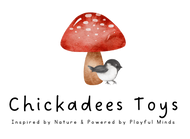Welcome to "Activity Bins with Allison," where Allison from @inspiredschoolhouse shares her journey and tips for creating engaging and educational activity bins for children.
As fans of Allison's creative bins, we at Chickadees have enjoyed her unique approach in incorporating each month's Playful Minds subscription into various activities. Don't forget to visit her Instagram for more inspiration!
Here's what Allison had to say about making and using activity bins:
I started making Activity Bins for my 4-year-old (at the time he was three years old). The Activity Bins were an easy way for me to have 3-4 developmentally appropriate learning activities readily available to him. He could independently pull out a bin, bring it to the table, and work on it.
As a parent, finding ways to keep young minds stimulated while also managing time efficiently is often a challenge. That's where activity bins come in—these simple yet effective tools have transformed our daily routine and learning experiences at home.

When I first started making the Activity Bins, he would often work on bins in the morning before breakfast. We would also use the Activity Bins during our homeschool time—my youngest would use his Activity Bins while I homeschooled my older children. Over time, I realized that my older kids (now 7 and 6 years old) were also interested in using the Activity Bins. So, I started making Activity Bins for my older kids that focused on specific skills they were working on—like math or reading skills.

The Activity Bins are a convenient way to have learning activities readily available. I can easily prep a set of Activity Bins at the beginning of the week. I like using containers with snap-on lids (that are easy for the child to open) that can easily stack on top of each other on a shelf. By using clear bins, it also allows the child to see what activity is in each bin without needing to open each one.

With the Activity Bins, I often include a sensory element—like a sensory filler or playdough. I find that having something to scoop and pour or manipulate with the hands often makes the learning activity more engaging for kids.
Creating activity bins has not only enriched my children’s learning experiences but also provided them with a sense of independence and curiosity. As they explore each bin, they're encouraged to solve problems and learn through play, fostering essential skills that will benefit them in the future.
If you're interested in trying this out, I've compiled a list of materials I use, including clear bins with snap lids, on my Amazon Storefront.
Shop My Activity Bin Amazon Storefront
In conclusion, activity bins have become an invaluable part of our homeschooling journey, offering structure and creativity in equal measure. They’re a fantastic way to ensure that educational activities are always at your fingertips, ready to inspire and engage your little learners. Whether you’re a homeschooling parent or simply looking for ways to enhance playtime, activity bins might just be the perfect solution for your family.

